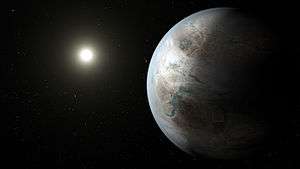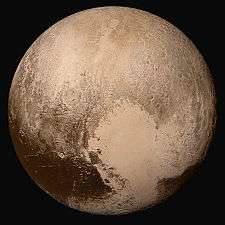V774104
| Discovery[1] | |
|---|---|
| Discovery site | Subaru Telescope |
| Discovery date | 13 October 2015 |
| Orbital characteristics | |
| Observation arc | ~2 weeks as of last report[2] |
| Physical characteristics | |
| Dimensions | 500–1000 km[1][3] |
| ~24[1][lower-alpha 1] | |
| ~4[1][4] | |
|
| |
V774104 is a trans-Neptunian object (TNO) with a radius roughly half that of Pluto or somewhat smaller. Currently it is approximately 103 AU from the Sun,[5][6] a distance of 15.4 billion kilometers (9.6 billion miles).[7] As of the discovery announcement in November 2015, it is the most distant observed object in the Solar System.[6][8] No astrometry has been submitted to the Minor Planet Center, so there are no publicly known orbital elements.
Discovery
V774104 was discovered by a team using the Subaru Telescope, a large reflecting telescope at the summit of Mauna Kea with a primary mirror 8 meters (26 ft) in diameter.[3] The discovery was announced at the November 2015 meeting of the American Astronomical Society’s Division for Planetary Sciences; the discovery team was led by Scott Sheppard and Chad Trujillo.[8]
Orbit
No astrometry has been released publicly so the object does not have a minor planet designation and the uncertainties of the orbital elements are unknown. Being a trans-Neptunian object so far from the Sun with an observation arc of just a few weeks at the time of its discovery announcement,[2] its perihelion and aphelion have not been securely determined.[lower-alpha 2]
Possible sednoid
V774104 might be a sednoid, an enigmatic class of objects in the outer Solar System with only two known members. Sednoids have eccentric orbits that must been perturbed by something, but could not have been perturbed by any presently known body (their entire orbits lie well outside the influence of Neptune). To be a sednoid, V774104 must have a perihelion greater than 50 AU and a semi-major axis greater than 150 AU, which can be determined when its observation arc is around one year. Only 3 objects are known to have perihelia (closest approach to the Sun) greater than 50 AU: 90377 Sedna, 2012 VP113, and 2004 XR190.[10][11] But 2004 XR190 has a low orbital eccentricity with perihelion at 51 AU.[10] Sedna and 2012 VP113 have both had their perihelion point lifted well beyond the classic Kuiper belt of 30–50 AU. If V774104 is a sednoid or extreme trans-Neptunian object, it may point towards an undiscovered shepherding planet hundreds of astronomical units from the Sun.[3][7] It is also possible, however, that the lifted perihelion was a result of the crowded confines of the open star cluster in which the Sun formed.[3] Discovery of additional sednoids and analysis of their orbits should eventually permit identification of the process by which their orbits were disturbed.[12]
Most distant Solar System object
Many news sources heralded V774104 as "the most distant Solar System object".[8] In fact, various long-period and hyperbolic comets are more distant,[7] though all of these are much smaller bodies and not observable at such distances.[lower-alpha 3] At the time of its discovery, the Voyager and Pioneer 10 spacecraft were also more distant; the Voyager probes are observable via their artificial radio transmissions.
| Object name | Distance from the Sun (AU) | Apparent magnitude |
Absolute magnitude (H) | |||||||||||||||||||||||||||||||||||||||||||||||||||||||||||||||||||||||||||||||||||||||||||||||
|---|---|---|---|---|---|---|---|---|---|---|---|---|---|---|---|---|---|---|---|---|---|---|---|---|---|---|---|---|---|---|---|---|---|---|---|---|---|---|---|---|---|---|---|---|---|---|---|---|---|---|---|---|---|---|---|---|---|---|---|---|---|---|---|---|---|---|---|---|---|---|---|---|---|---|---|---|---|---|---|---|---|---|---|---|---|---|---|---|---|---|---|---|---|---|---|---|---|---|
| Current | Perihelion | Aphelion | ||||||||||||||||||||||||||||||||||||||||||||||||||||||||||||||||||||||||||||||||||||||||||||||||
| V774104 | 103 | N/A | N/A | 24 | 4 | |||||||||||||||||||||||||||||||||||||||||||||||||||||||||||||||||||||||||||||||||||||||||||||
| Eris | 96.2 | 37.8 | 97.6 | 18.7 | -1.2 | |||||||||||||||||||||||||||||||||||||||||||||||||||||||||||||||||||||||||||||||||||||||||||||
| 2014 UZ224 | 91.6 | 38.0 | 179.8 | 23.2 | 3.5 | |||||||||||||||||||||||||||||||||||||||||||||||||||||||||||||||||||||||||||||||||||||||||||||
| 2007 OR10 | 87.6 | 33.0 | 100.8 | 21.7 | 2.5 | |||||||||||||||||||||||||||||||||||||||||||||||||||||||||||||||||||||||||||||||||||||||||||||
| 2013 FS28 | 86.2 | 34.6 | 347.6 | 24.5 | 4.9 | |||||||||||||||||||||||||||||||||||||||||||||||||||||||||||||||||||||||||||||||||||||||||||||
| Sedna | 85.6 | 76.0 | 939 | 21.0 | 1.6 | |||||||||||||||||||||||||||||||||||||||||||||||||||||||||||||||||||||||||||||||||||||||||||||
| 2014 FC69 | 84.4 | 40.3 | 106.9 | 24.1 | 4.6 | |||||||||||||||||||||||||||||||||||||||||||||||||||||||||||||||||||||||||||||||||||||||||||||
| 2006 QH181 | 83.6 | 37.8 | 96.7 | 23.6 | 4.3 | |||||||||||||||||||||||||||||||||||||||||||||||||||||||||||||||||||||||||||||||||||||||||||||
| 2012 VP113 | 83.3 | 80.5 | 438 | 23.4 | 4.0 | |||||||||||||||||||||||||||||||||||||||||||||||||||||||||||||||||||||||||||||||||||||||||||||
| 2013 FY27 | 80.2 | 36.1 | 81.8 | 22.1 | 3.0 | |||||||||||||||||||||||||||||||||||||||||||||||||||||||||||||||||||||||||||||||||||||||||||||
| 2014 FJ72 | 71.1 | 38.7 | 152.2 | 24.2 | 5.6 | |||||||||||||||||||||||||||||||||||||||||||||||||||||||||||||||||||||||||||||||||||||||||||||
| 2010 GB174 | 71.1 | 48.7 | 693 | 25.1 | 6.5 | |||||||||||||||||||||||||||||||||||||||||||||||||||||||||||||||||||||||||||||||||||||||||||||
| 2012 FH84 | 68.6 | 45.8 | 80.6 | 25.7 | 7.3 | |||||||||||||||||||||||||||||||||||||||||||||||||||||||||||||||||||||||||||||||||||||||||||||
| 2011 GM89 | 68.3 | 37.2 | 68.8 | 25.6 | 7.1 | |||||||||||||||||||||||||||||||||||||||||||||||||||||||||||||||||||||||||||||||||||||||||||||
| 2015 GR50 | 68.2 | 35.6 | 78.6 | 25.1 | 6.7 | |||||||||||||||||||||||||||||||||||||||||||||||||||||||||||||||||||||||||||||||||||||||||||||
| 2015 GP50 | 68.1 | 35.9 | 89.1 | 24.8 | 6.5 | |||||||||||||||||||||||||||||||||||||||||||||||||||||||||||||||||||||||||||||||||||||||||||||
| 2013 FQ28 | 67.5 | 48.7 | 80.6 | 24.4 | 6.0 | |||||||||||||||||||||||||||||||||||||||||||||||||||||||||||||||||||||||||||||||||||||||||||||
| 2013 UJ15 | 64.4 | 36.3 | 69.2 | 25.2 | 7.0 | |||||||||||||||||||||||||||||||||||||||||||||||||||||||||||||||||||||||||||||||||||||||||||||
| 2015 RR245 | 63.9 | 33.7 | 129.2 | 22.1 | 3.9 | |||||||||||||||||||||||||||||||||||||||||||||||||||||||||||||||||||||||||||||||||||||||||||||
| 2014 SG350 | 63.0 | 39.9 | 63.9 | 24.8 | 6.8 | |||||||||||||||||||||||||||||||||||||||||||||||||||||||||||||||||||||||||||||||||||||||||||||
| 2014 FL72 | 62.1 | 38.2 | 170.4 | 25.0 | 6.8 | |||||||||||||||||||||||||||||||||||||||||||||||||||||||||||||||||||||||||||||||||||||||||||||
| 2013 AT183 | 62.1 | 36.0 | 88.1 | 22.0 | 4.7 | |||||||||||||||||||||||||||||||||||||||||||||||||||||||||||||||||||||||||||||||||||||||||||||
| 2014 FE72 | 61.8 | 36.3 | 4274.0 | 24.1 | 6.1 | |||||||||||||||||||||||||||||||||||||||||||||||||||||||||||||||||||||||||||||||||||||||||||||
| 2014 SV349 | 61.3 | 34.2 | 89.0 | 23.0 | 5.0 | |||||||||||||||||||||||||||||||||||||||||||||||||||||||||||||||||||||||||||||||||||||||||||||
| 2000 CR105 | 60.8 | 44.3 | 412 | 23.9 | 6.3 | |||||||||||||||||||||||||||||||||||||||||||||||||||||||||||||||||||||||||||||||||||||||||||||
| 2014 SU349 | 60.7 | 30.8 | 109.8 | 25.0 | 7.0 | |||||||||||||||||||||||||||||||||||||||||||||||||||||||||||||||||||||||||||||||||||||||||||||
| 2014 FF72 | 60.7 | 37.1 | 63.3 | 24.8 | 6.9 | |||||||||||||||||||||||||||||||||||||||||||||||||||||||||||||||||||||||||||||||||||||||||||||
| 2014 FM72 | 60.4 | 34.4 | 76.6 | 24.1 | 6.2 | |||||||||||||||||||||||||||||||||||||||||||||||||||||||||||||||||||||||||||||||||||||||||||||
| 2014 FH72 | 60.1 | 37.3 | 77.3 | 25.1 | 7.2 | |||||||||||||||||||||||||||||||||||||||||||||||||||||||||||||||||||||||||||||||||||||||||||||
| 2008 ST291 | 60.1 | 42.4 | 154.5 | 22.2 | 4.2 | |||||||||||||||||||||||||||||||||||||||||||||||||||||||||||||||||||||||||||||||||||||||||||||
| 2003 QX113 | 60.0 | 36.7 | 62.1 | 22.5 | 4.7 | |||||||||||||||||||||||||||||||||||||||||||||||||||||||||||||||||||||||||||||||||||||||||||||
| 2015 KH162 | 59.2 | 41.5 | 82.8 | 21.6 | 3.9 | |||||||||||||||||||||||||||||||||||||||||||||||||||||||||||||||||||||||||||||||||||||||||||||
| Including all known objects currently located at least twice as far as Neptune.[13] See List of trans-Neptunian objects for more. | ||||||||||||||||||||||||||||||||||||||||||||||||||||||||||||||||||||||||||||||||||||||||||||||||||
Observed Solar System objects that periodically become more distant than 103 AU from the Sun include Sedna (which is similar or modestly larger in size), 2000 CR105, 2012 DR30, 2013 BL76, and 2005 VX3. There are 595 known objects that have aphelia more than 103 AU from the Sun.[14] This distance is about double the outer limit of the torus-shaped Kuiper belt that lies outside Neptune's orbit. Far beyond this region is the vast spherical Oort cloud enshrouding the Solar System, whose presence was deduced from the orbits of long-period comets.
Study of the population of Solar System objects that are significantly more distant than V774104 will likely require new instruments. The proposed Whipple spacecraft mission is designed to determine the outer limit of the Kuiper belt and directly detect Oort cloud objects out to 10,000 AU. Such objects are too small to detect with current telescopes except during stellar occultations. The proposal involves use of a wide field of view and rapid recording cadence to allow detection of many such events.[15]
See also
- Discovery and exploration of the Solar System
- List of Solar System objects most distant from the Sun in 2015
- U (TNO)
Notes
- ↑ The size estimate of 500–1000 km leads to an absolute magnitude (H) of 3.5–4.0, which at 103 AU is apparent magnitude 24–24.5.
- ↑ For comparison Trans-Neptunian object 2015 SO20 with an observation arc of only 28 days had large uncertainties for perihelion and aphelion.[9]
- ↑ For example, as of 2015, comet C/1927 X1 (Skjellerup-Maristany) is 109 AU from the Sun
References
- 1 2 3 4 Kelly Beatty (21 November 2015). "V774104: Solar System's Most Distant Object". Sky & Telescope. Retrieved 2015-11-22.
- 1 2 Cofield, C. (2015-11-12). "New Dwarf Planet In Our Solar System May Be The Farthest One Yet". Space.com. Retrieved 2015-11-13.
- 1 2 3 4 "Most distant solar system object yet could hint at hidden planet". New Scientist. 10 November 2015.
- ↑ "Absolute Magnitude (H)". NASA/JPL.
- ↑ WIRED, Solar System's most distant object hints at hidden planet
- 1 2 Hand, E. (2015-11-10). "Astronomers spot most distant object in the solar system, could point to other rogue planets". News.ScienceMag.org. AAAS. Retrieved 2015-11-11.
- 1 2 3 Astronomy Now Magazine – Newly discovered dwarf planet is solar system’s most distant object
- 1 2 3 BBC News, Most distant' Solar System object spied
- ↑ "JPL Small-Body Database Browser: (2015 SO20)" (last observation: 2015-10-18 ; arc: 28 days). Jet Propulsion Laboratory. Archived from the original on November 13, 2015. Retrieved 2015-11-13.
- 1 2 "JPL Small-Body Database Search Engine: q > 50 (AU)". JPL Solar System Dynamics. Retrieved 2015-11-12.
- ↑ "Minor Planet Center: q > 50 (AU)". Minor Planet Center. Retrieved 2015-11-12.
- ↑ Schwamb, M. E. (2007). "Searching for Sedna's Sisters: Exploring the inner Oort cloud" (PDF). Caltech. Archived from the original (PDF) on 2013-05-12. Retrieved 2015-11-15.
- 1 2 "AstDyS-2, Asteroids - Dynamic Site". 2016-02-26. Retrieved 2016-02-29.
Objects with distance from Sun over 59 AU
- ↑ "JPL Small-Body Database Search Engine: Q > 103 (AU)". JPL Solar System Dynamics. Retrieved 2015-11-12.
- ↑ The Whipple Mission Exploring the Oort Cloud and the Kuiper Belt – C Alcock et al.



